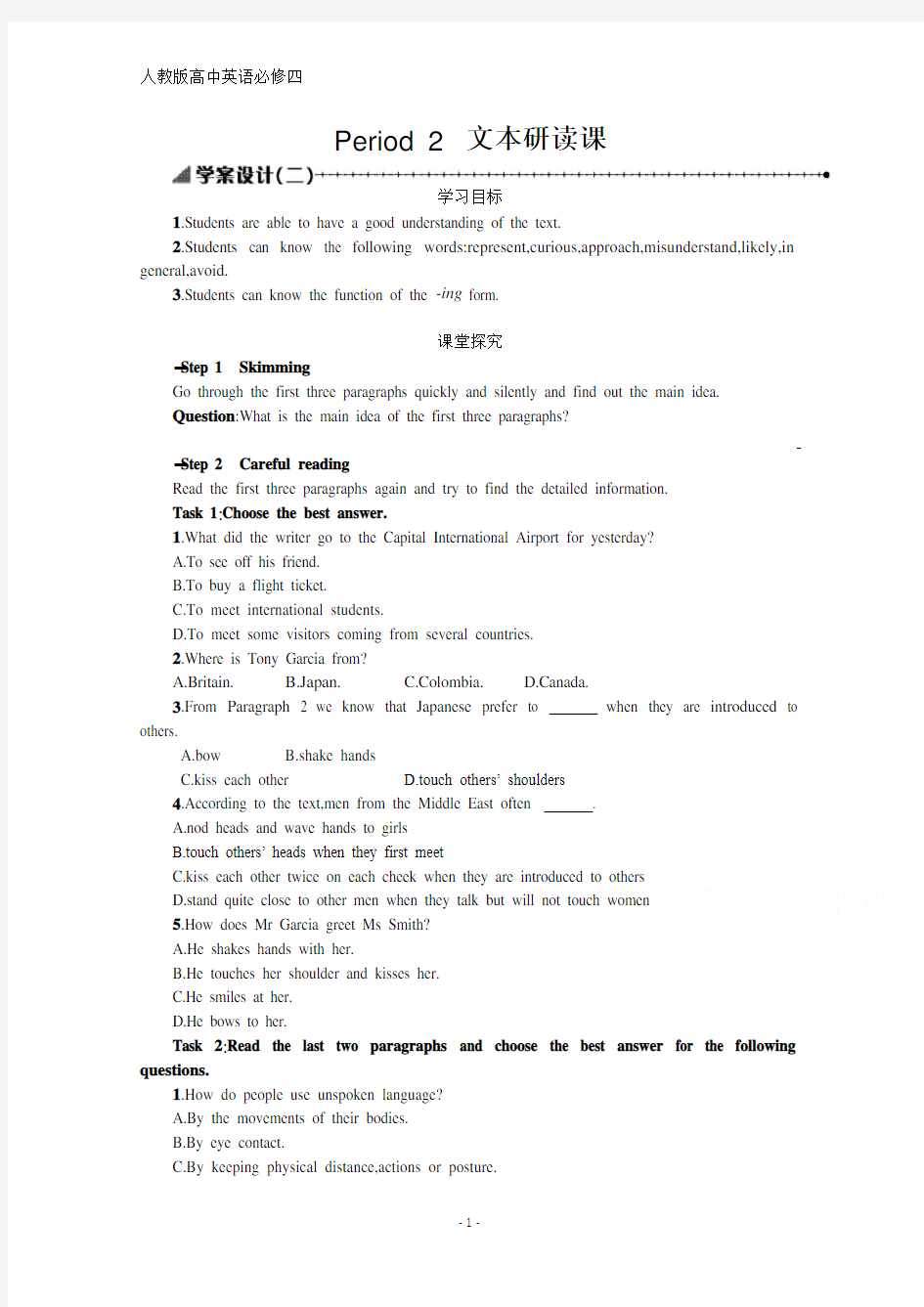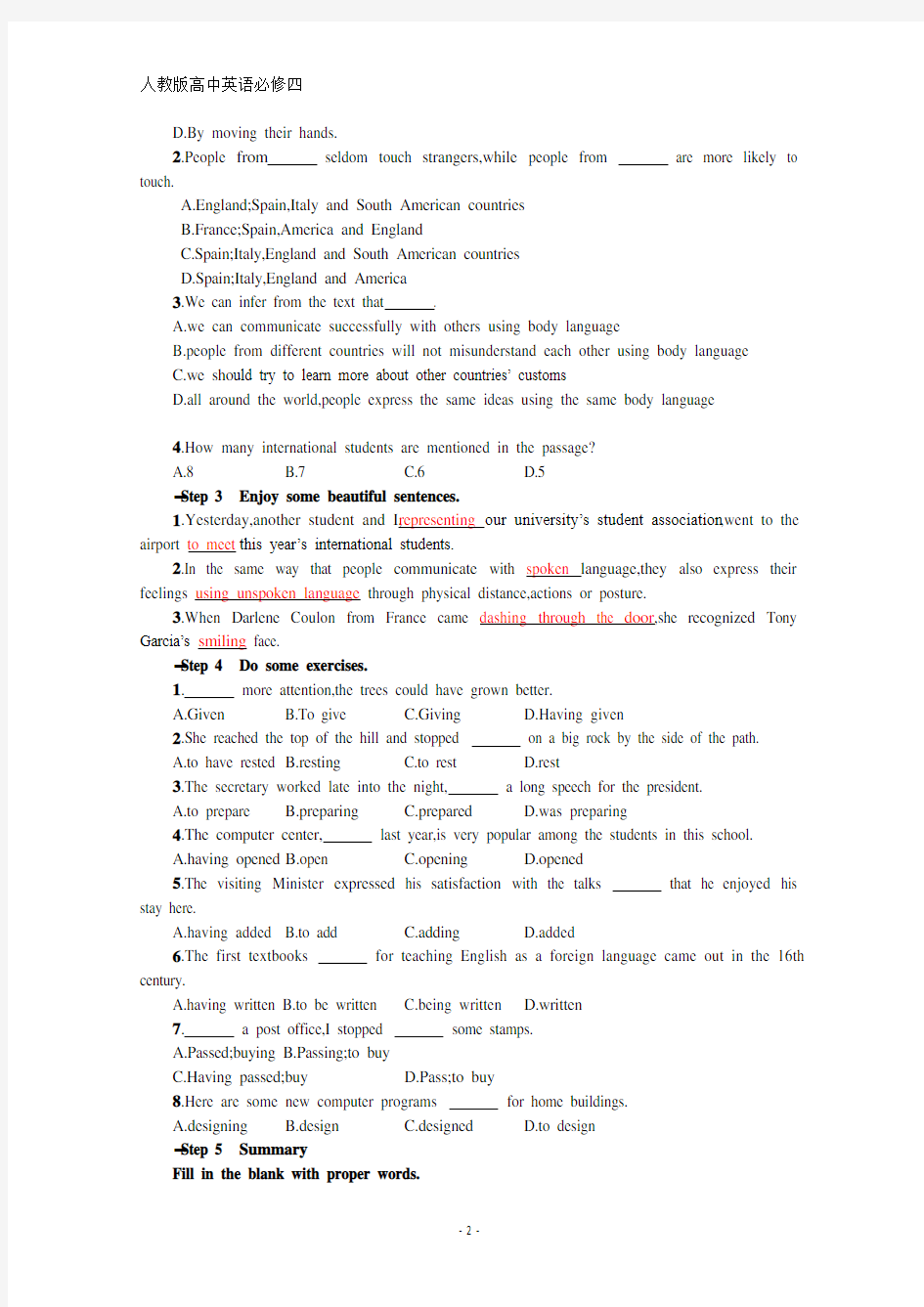英语高中人教版必修4学案:Unit4 4.2 二含解析


Period 2文本研读课
学习目标
1.Students are able to have a good understanding of the text.
2.Students can know the following words:represent,curious,approach,misunderstand,likely,in general,avoid.
3.Students can know the function of the -ing form.
课堂探究
?Step 1Skimming
Go through the first three paragraphs quickly and silently and find out the main idea.
Question:What is the main idea of the first three paragraphs?
?Step 2Careful reading
Read the first three paragraphs again and try to find the detailed information.
Task 1:Choose the best answer.
1.What did the writer go to the Capital International Airport for yesterday?
A.To see off his friend.
B.To buy a flight ticket.
C.To meet international students.
D.To meet some visitors coming from several countries.
2.Where is Tony Garcia from?
A.Britain.
B.Japan.
C.Colombia.
D.Canada.
3.From Paragraph 2 we know that Japanese prefer to when they are introduced to others.
A.bow
B.shake hands
C.kiss each other
D.touch others’ shoulders
4.According to the text,men from the Middle East often .
A.nod heads and wave hands to girls
B.touch others’ heads when they first meet
C.kiss each other twice on each cheek when they are introduced to others
D.stand quite close to other men when they talk but will not touch women
5.How does Mr Garcia greet Ms Smith?
A.He shakes hands with her.
B.He touches her shoulder and kisses her.
C.He smiles at her.
D.He bows to her.
Task 2:Read the last two paragraphs and choose the best answer for the following questions.
1.How do people use unspoken language?
A.By the movements of their bodies.
B.By eye contact.
C.By keeping physical distance,actions or posture.
D.By moving their hands.
2.People from seldom touch strangers,while people from are more likely to touch.
A.England;Spain,Italy and South American countries
B.France;Spain,America and England
C.Spain;Italy,England and South American countries
D.Spain;Italy,England and America
3.We can infer from the text that.
A.we can communicate successfully with others using body language
B.people from different countries will not misunderstand each other using body language
C.we sho uld try to learn more about other countries’ customs
D.all around the world,people express the same ideas using the same body language
4.How many international students are mentioned in the passage?
A.8
B.7
C.6
D.5
?Step 3Enjoy some beautiful sentences.
1.Yesterday,another student and I,representing our university’s student association,went to the airport to meet this year’s international students.
2.In the same way that people communicate with spoken language,they also express their feelings using unspoken language through physical distance,actions or posture.
3.When Darlene Coulon from France came dashing through the door,she recognized Tony Garcia’s smiling face.
?Step 4Do some exercises.
1.more attention,the trees could have grown better.
A.Given
B.To give
C.Giving
D.Having given
2.She reached the top of the hill and stopped on a big rock by the side of the path.
A.to have rested
B.resting
C.to rest
D.rest
3.The secretary worked late into the night, a long speech for the president.
A.to prepare
B.preparing
C.prepared
D.was preparing
4.The computer center,last year,is very popular among the students in this school.
A.having opened
B.open
C.opening
D.opened
5.The visiting Minister expressed his satisfaction with the talks that he enjoyed his stay here.
A.having added
B.to add
C.adding
D.added
6.The first textbooks for teaching English as a foreign language came out in the 16th century.
A.having written
B.to be written
C.being written
D.written
7. a post office,I stopped some stamps.
A.Passed;buying
B.Passing;to buy
C.Having passed;buy
D.Pass;to buy
8.Here are some new computer programs for home buildings.
A.designing
B.design
C.designed
D.to design
?Step 5Summary
Fill in the blank with proper words.
Not all cultures 1.each other in the same way.Each country may have its own way to 2.feelings.In Britain,people may keep a 3.distance.In Japan,people may 4. to each other when they meet.In France,people 5.hands and kiss each other twice on each 6..And in South American countries,they may stand 7.and touch each other.But in Middle East Muslim countries,they shake hands only with men,not with women.In China today,people may shake hands with each other,sometimes they greet each other only with a 8..
?Step 6Homework
1.Retell the passage in your own words.
2.Do some research on body language by surfing the Internet or reading books and make a report.
课后提升
1.Find out different ways for people to greet.
2.Translate the following sentences.
(1)各种文化背景下的人互致问候的方式不尽相同,身体接触和相互间距的程度也并不一样。
(2)在当今文化交融的世界,学习不同国家的习俗肯定能帮助我们避免交往中的困难。
参考答案
课堂探究
Step 1:Different international students behave differently when they greet people.
Step 2:Task 1:1.C2.C3.A4.D5.B
Task 2:1.C2.A3.C4.C
Step 4:1.A2.C3.B4.D5.C6.D7.B8.C
Step 5:1.greet2.express3.certain4.bow5.shake6.cheek7.close8.smile
课后提升
1.People greet each other by shaking hands,kissing on the cheek or bowing in different countries.
2.(1)Not all cultures greet each other the same way,nor are they comfortable in the same way with touching or distance between people.
(2)Studying international customs can certainly help avoid difficulties in today’s world of cultural crossroads.
